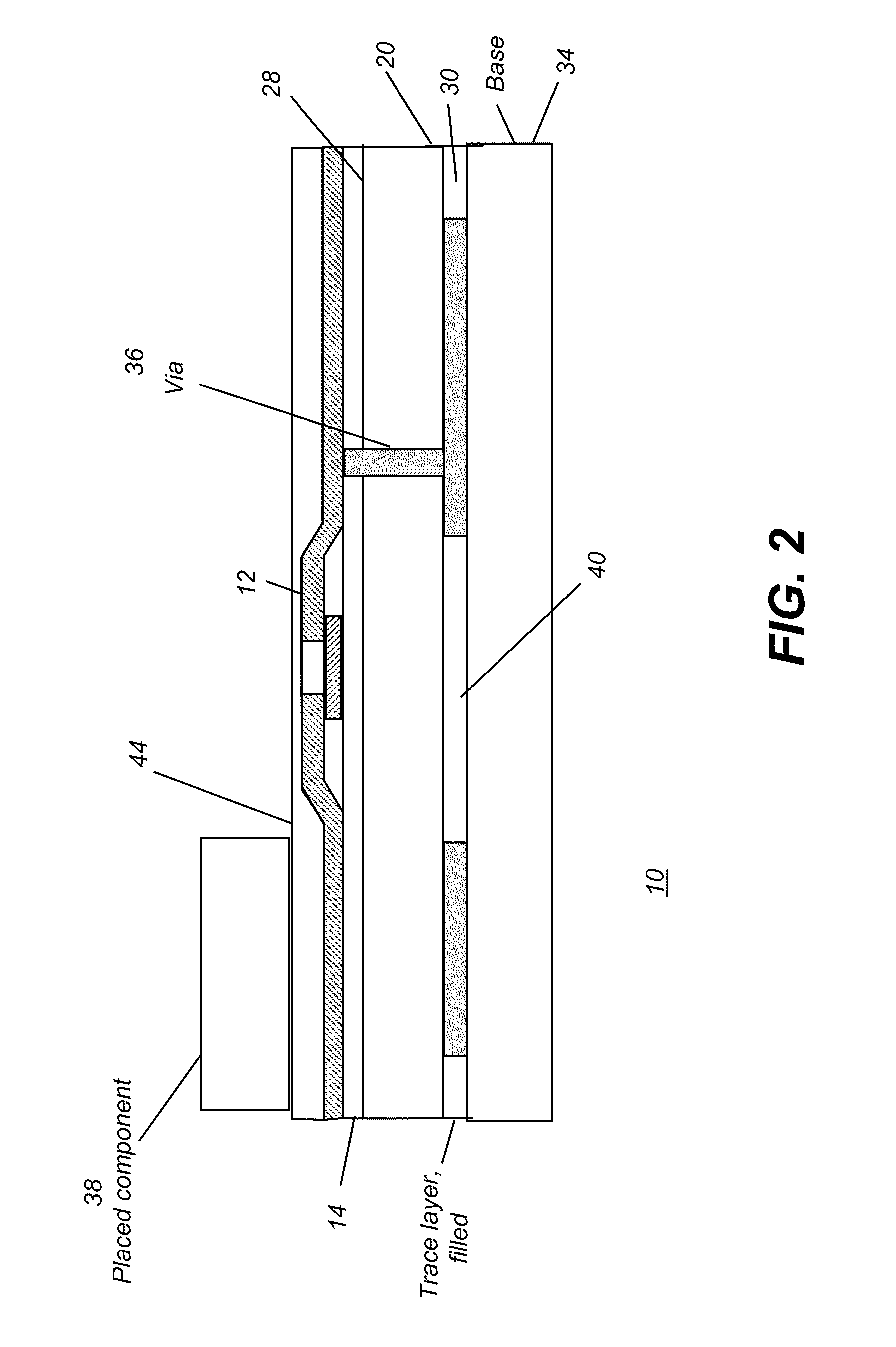Flexible substrate with electronic devices and traces
a flexible substrate technology, applied in the field of electronic devices, to achieve the effect of improving lamination
- Summary
- Abstract
- Description
- Claims
- Application Information
AI Technical Summary
Benefits of technology
Problems solved by technology
Method used
Image
Examples
example 1
[0069]In one embodiment, the material used for composite substrate 20 is a PTFE woven fiberglass laminate, such as a material from the DiClad 522, 527 Series available from Arlon, Inc. Rancho Cucamonga, Calif. Dimensionally stable under temperature stress, PTFE woven fiberglass laminates have been used, for example, for printed circuit boards (PCBs) and, when used for this purpose, are supplied with a copper layer, typically an electrodeposited copper layer. For use as a flexible substrate 20, an ideal thickness for PTFE woven fiberglass laminate is in the range of about 25 microns to about 3000 microns.
[0070]Given this substrate, TFT fabrication processing is as follows:[0071]1. Mounting on carrier 18. The flexible substrate is initially laminated onto a glass carrier 18. This is done by positioning substrate 20 on carrier 18 and treating this combination by applying heat and pressure to achieve the flow temperature (Tg) of the PTFE material, approximately 300 degrees C. The PTFE m...
example 2
[0082]This next example considers additional steps that may be needed in order to formulate composite substrate 20. The basic steps are as follows:[0083]1. Heat the plastic to its melt temperature Tg.[0084]2. Add particulate material 16 to the melted plastic as a filler. For improved bonding, particulate material 16 works best if deposited on or near the surface of substrate 20. For improved CTE, however, a more general distribution of particles mixed throughout the plastic material is preferred. In most cases, it is preferred to have a thicker concentration of particulate material 16, or exposed portions of particulate material 16 near the surface of substrate 20. Thus, this step would require some mixing of particulate material 16 with the melted plastic binder.[0085]3. Mounting on carrier 18. The flexible substrate is initially laminated onto a glass carrier 18, as is shown in FIG. 7A. This is done by positioning substrate 20 on carrier 18 and treating this combination by applyin...
example 3
[0094]In another embodiment, substrate 20 is formed from polyimide or a polyimide composition and binder, using the following steps:[0095]1. Coat uncured plastic binder material onto a suitable carrier. Here, partially cured polyimide is coated onto the carrier. Any suitable method of application can be used, including dip-skiving, spun-on application, or extrusion.[0096]2. Cure the uncured plastic material until the curing process is largely completed.[0097]3. When approximately 80% of the curing cycle is complete, add particulate material 16 onto the surface of substrate 20. Here, the particulate material 16 is sprinkled onto the surface, to provide an even coating.[0098]4. Complete the curing process, baking off the remaining solvent.[0099]5. Planarization. The desired surface roughness for TFT deposition can be on the order of less than 0.2 to 0.3 microns peak-to-peak in some applications. In order to achieve this, spun-on glass (SOG) is deposited. To apply this substance, a sol...
PUM
| Property | Measurement | Unit |
|---|---|---|
| thicknesses | aaaaa | aaaaa |
| thickness | aaaaa | aaaaa |
| surface roughness | aaaaa | aaaaa |
Abstract
Description
Claims
Application Information
 Login to View More
Login to View More - R&D
- Intellectual Property
- Life Sciences
- Materials
- Tech Scout
- Unparalleled Data Quality
- Higher Quality Content
- 60% Fewer Hallucinations
Browse by: Latest US Patents, China's latest patents, Technical Efficacy Thesaurus, Application Domain, Technology Topic, Popular Technical Reports.
© 2025 PatSnap. All rights reserved.Legal|Privacy policy|Modern Slavery Act Transparency Statement|Sitemap|About US| Contact US: help@patsnap.com



